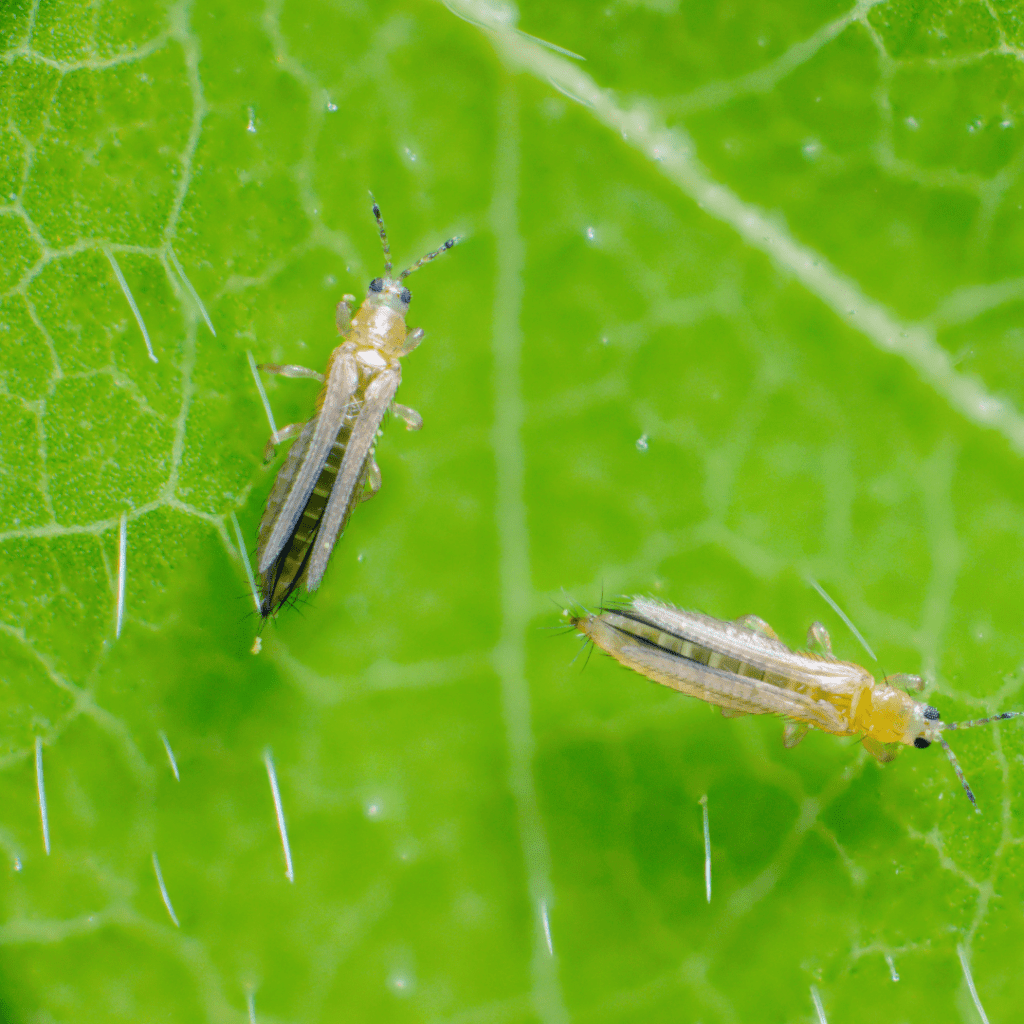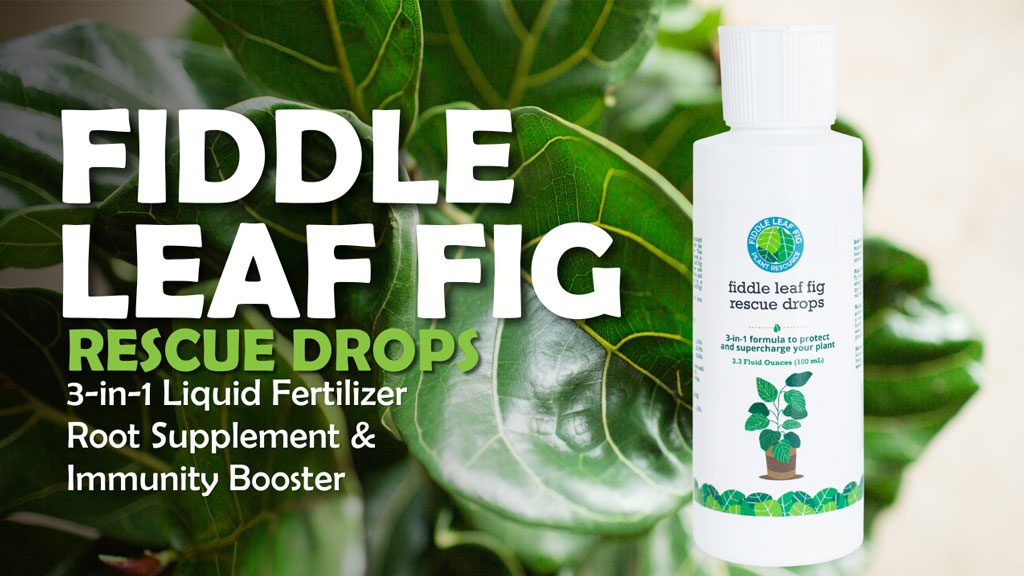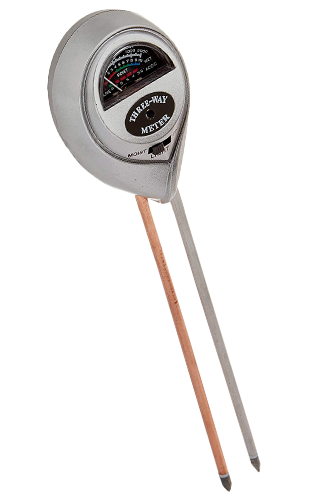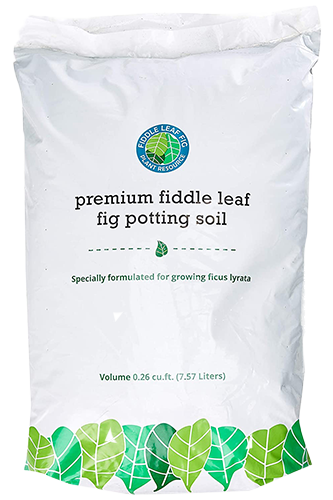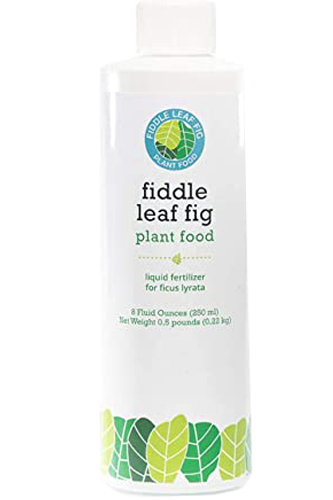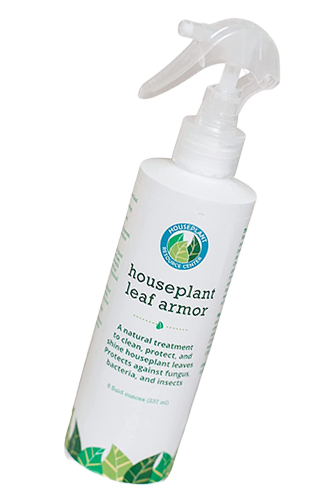The Silent Invaders: A Beginner’s Guide to Spotting Thrips and Springtails in Fiddle Leaf Figs
A few thrips and springtails on a fiddle leaf fig plant may not seem like a big deal, but in reality, these silent invaders can quickly become a nightmare for growers. Mastering pest control starts with understanding what to look for so you can take action before it’s too late.

Thrips and Springtails in Fiddle Leaf Fig Plants: What is the Difference?
Appearance
The easiest way to tell the difference between thrips and springtails is by their appearance. Thrips are tiny, slender insects with fringed wings, while springtails are small, wingless creatures that often get mistaken for fleas.
With over 6000 thrip species, these pests may appear yellow, brown, black, or light green depending on the growth stage and type. On the other hand, springtails are typically whitish, blueish, dark brown, black, or gray.
Springtails measure about .24″ in length, making them visible to the naked eye and easier to identify on your fiddle leaf fig. Thrips are significantly smaller, measuring .02″ to .04″. As a result, you’ll need a magnifying glass to see these pests as anything other than dark hair or specks of soil.
Breeding Habits
Both thrips and springtails have a fast breeding cycle that can create thousands of offspring in a short amount of time. However, some differences in their breeding habits can help you distinguish between them.
Thrips are in their active breeding cycle during warmer months in the spring and summer. When this cycle begins, female thrips emerge from the soil to lay eggs in plant tissues along the leaves and stem. As such, if it’s warm and you see tiny black or white scars on the leaves where the eggs have been laid, chances are there is a thrip problem.
Springtails don’t mind the cold; they can reproduce as long as there is moisture. Females lay eggs in the soil, making them harder to spot – but not impossible. Because these pests lay up to 150 eggs at a time, you’ll notice a snowy build-up of yellowish or white dots in the topsoil or leaf debris.
Feeding Routine
Thrips feed on plant sap, using their sharp mouthparts to pierce fiddle leaf fig roots, leaves, and stems. Feeding as a group, thrips look like a dusting of pepper on plant leaves, with a heavy concentration on the leaf’s midrib (center vein).
Springtails don’t feed on plants but on decaying plant matter and fungi. These food sources contain the protein and nutrients they need to survive, so you may notice a build-up of springtails in moist soil or on the bottom of your plant pot during feeding times.
Movement
Even though they have wings, thrips aren’t great flyers. So, they’ll usually make their way to your fiddle leaf fig by climbing on nearby plants or being carried in by wind currents. You may also see them crawling up from the base of the soil.
Springtails get around a little differently, with a unique appendage called a furcula that allows them to jump several inches into the air. This helps them move quickly from plant to plant and makes them harder to contain.
Because both are most active when disturbed, tapping fiddle leaf fig leaves and soil is the best way to get these pests moving for proper identification. Typically, though not always, thrips will create a cloudy swarm when disturbed, whereas springtails will look more like a scattering of specks.
Identifying Thrip and Springtail Damage In Fiddle Leaf Fig Plants
Nutrient Deficiencies
Thrips are known for causing cell deterioration due to aggressive feeding habits. With diminished ability to absorb nutrients, fiddle leaf figs may experience stunted growth, yellowing or browning of leaves, and wilting.
While springtails don’t harm the plant the same way, their presence is a sign of overwatering and excess moisture, which can disrupt root growth and nutrient uptake.
Pro Tip: Use a fiddle leaf fig multivitamin to supplement nutrient deficiencies in your precious houseplant.
Leaf Deformities
Because springtails feed on moisture, one of the tell-tale signs of an infestation is curled or wilted leaves. You may also notice small holes in leaf tissue where springtails have laid eggs. You may also see the common leaf deformities of overwatering, such as drooping and yellowing leaves.
The extent of leaf damage is much more prominent with thrips. Their aggressive feeding habits leave plants susceptible to harmful bacteria and viruses they carry. Heavy infestations often cause brown patches on leaves where the thrips have fed, eventually leading to leaf drop.
Root Deterioration
Both thrips and springtails can cause root damage but for different reasons. While both feed directly on the roots, thrips cause physical damage to the roots themselves, making it difficult for the plant to absorb nutrients and water. This results in a fast decline in plant hardiness, wilting, and yellowing of leaves.
Springtails, on the other hand, feed on root fungi that can cause plant rot. This can lead to a weakened root structure and eventually plant death if not caught early enough. Plus, because springtails thrive in moist environments, failure to spot and treat them means you leave your plant vulnerable to root rot.
Pro Tip: Solve root rot related to infestations and overwatering with a natural root supplement designed to work fast.
Thrips and Springtails: An Infestation Timeline
It takes about 2 weeks for thrips and approximately a month for springtails to infest a plant. The first stages are most apparent in the soil, where tiny white or black specs appear in a build-up in the topsoil.
These specs may or may not move when disturbed, so close inspection with a magnifying glass is key. Visible signs of an early soil infection include:
- cocoon-like structures in the soil
- translucent eggs
- tiny white nymphs crawling around the roots
You may also notice initial signs of nutrient deficiency or overwatering. It is much easier to treat and control if you can catch the infestation at this stage. However, if left unchecked, thrips and springtails will soon emerge from the soil and make their way onto the leaves of your fiddle leaf fig.
Once emerged, the infestation moves up the plant, with pests finding homes in the crevices of leaves and stems. Numbers may seem relatively small at this point, leading many growers to use leaf shine wipes as a quick solution.
But, because thrips and springtails have a fast breeding cycle, what starts as a few pests can quickly turn into a complete dusting of your plant. Once this happens, the infection is most dangerous to your fiddle leaf fig.
The mass infection causes a rapid decline in plant health due to physical damage, unhealthy moisture conditions, and nutrient deficiencies. Within two weeks to a month, your fiddle leaf fig can go from green and vibrant to struggling or dead due to an unchecked thrip or springtail infestation.
How To Stop Thrip and Springtail Infestations
Don’t overwater.
Overwatering creates the perfect environment for thrips and springtails to thrive. Using a moisture meter or simply checking the top inch of soil for dryness before watering, you can avoid creating the perfect breeding ground for these pests.
Maintain a frequent care routine.
Plants show signs of distress early on, and having a frequent care routine makes you more likely to catch an infestation before it wreaks havoc on a plant. This means regularly checking the soil, inspecting the leaves and stems for pests, and addressing any potential issues promptly.
Use premium soil.
Premium fiddle leaf fig soil is crucial to prevent the ideal conditions for pests to breed. A high-quality, well-draining soil mix will help avoid overwatering, strengthen plant immunity, and keep pests from easily infiltrating the soil.
Prune plant leaves.
Leaf debris and dying leaves are a breeding ground for pests. Regularly pruning your plant will limit these areas and make it harder for thrips and springtails to thrive. Plus, removing infested leaves with sharp pruning shears will help contain the spread of the infestation.
FAQ: Thrips and Springtails
1. Are thrips and springtails harmful to humans?
No, thrips and springtails are not harmful to humans. They may be a nuisance if found in large numbers, but they do not pose any direct health risks.
2. Can I have more than one pest infestation at a time?
Yes, it is possible to have multiple pest infestations at the same time. In addition to thrips and springtails, you can have mealybugs, spider mites, or aphids infesting a fiddle leaf fig plant.
3. How can I tell the difference between thrips and springtails?
The key difference will be the presence of wings. Thrips have slender wings, while springtails do not have any wings at all. Additionally, thrips are typically found on leaves, while springtails are more commonly found in the soil.
Identify Fiddle Leaf Fig Pests for a Happy, Healthy Plant
Knowing the signs and symptoms of common pests like thrips and springtails can help you catch an infestation early on and take the necessary steps to control it. With proper care, including regular inspections, a well-draining soil mix, and appropriate watering practices, you can keep your fiddle leaf fig free from these pesky critters and enjoy a beautiful, healthy plant.
Not sure what pest is affecting your plant? Join our online Fiddle Leaf Fig community and subscribe to our newsletter for the latest in fiddle leaf fig care, products, and growing tips.

